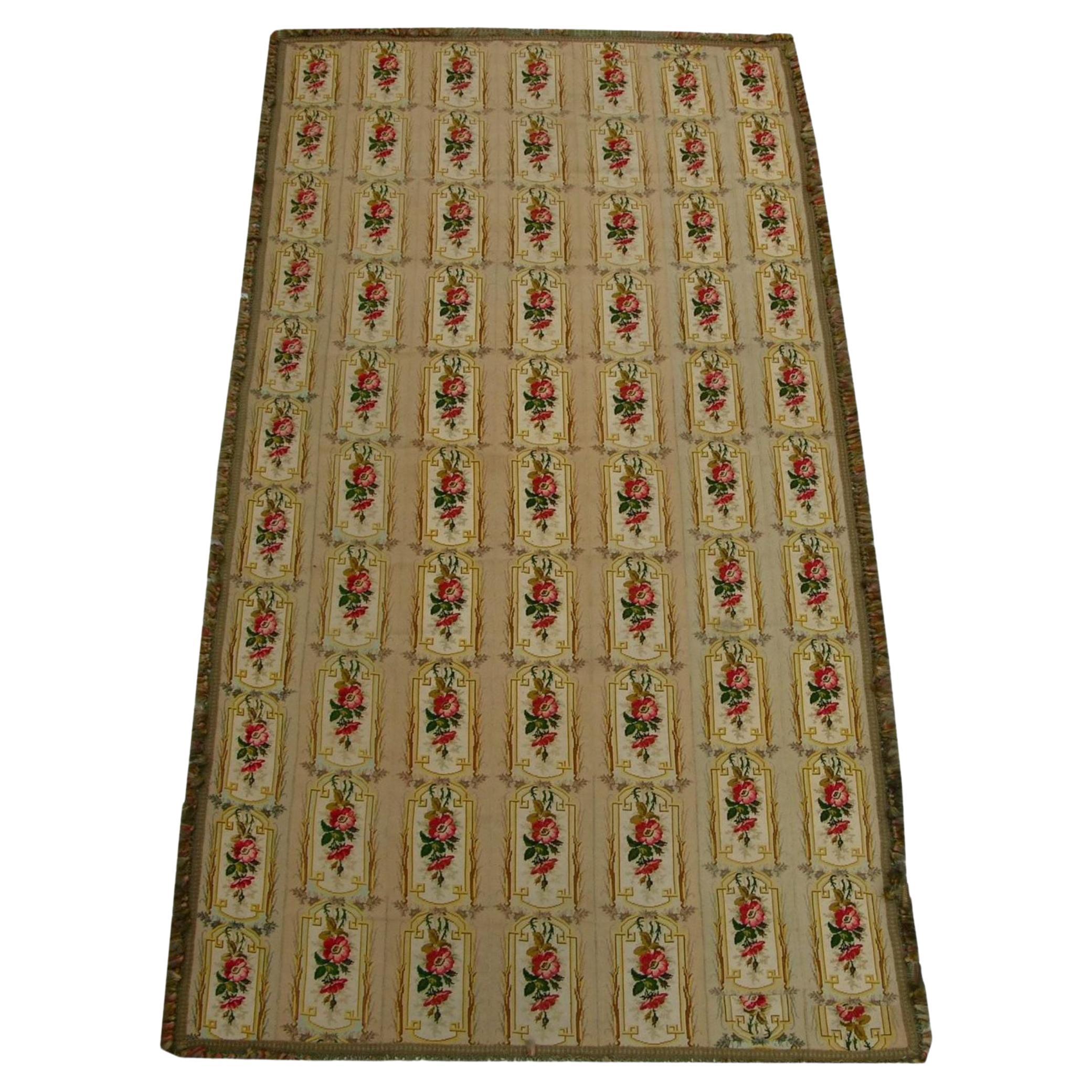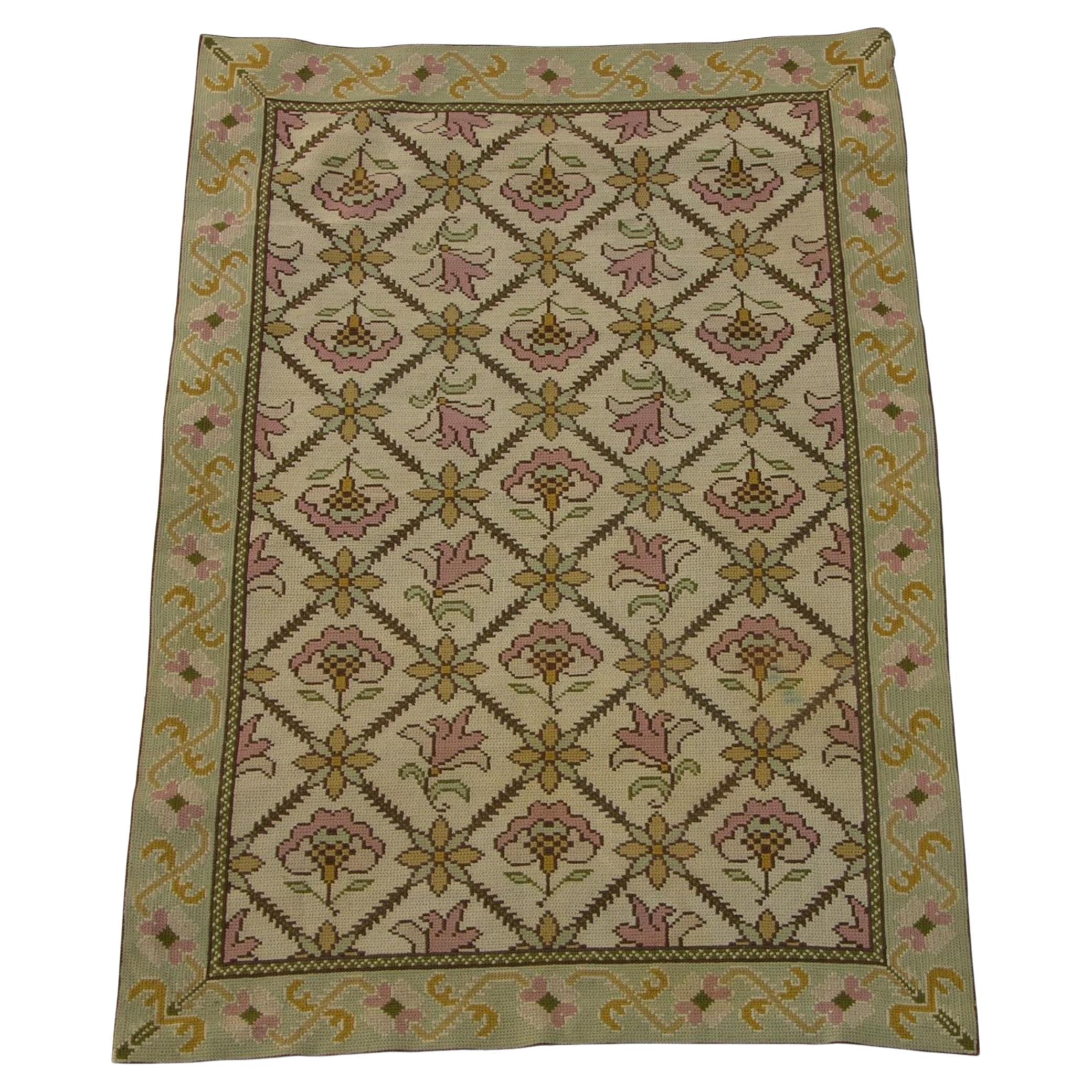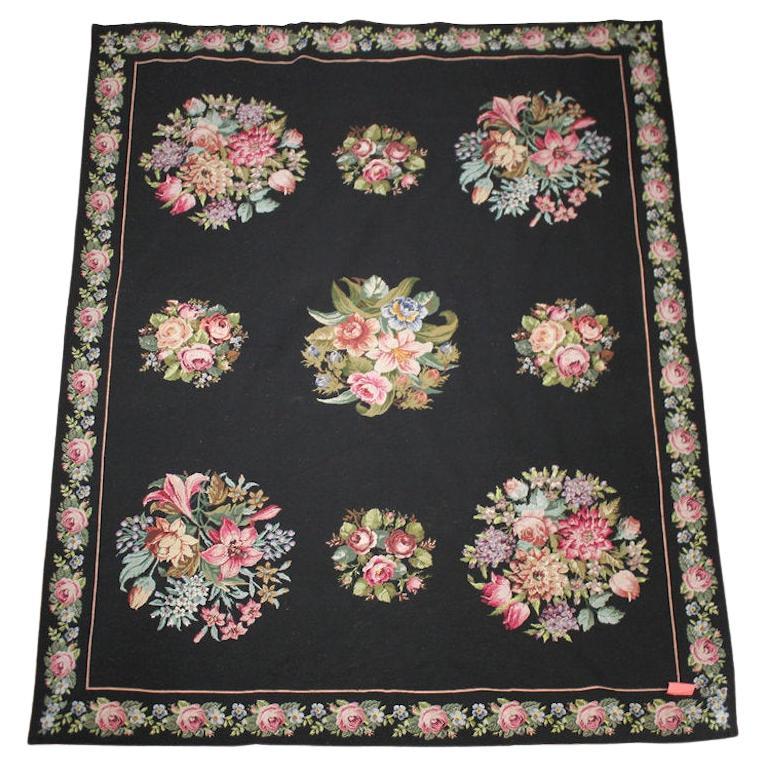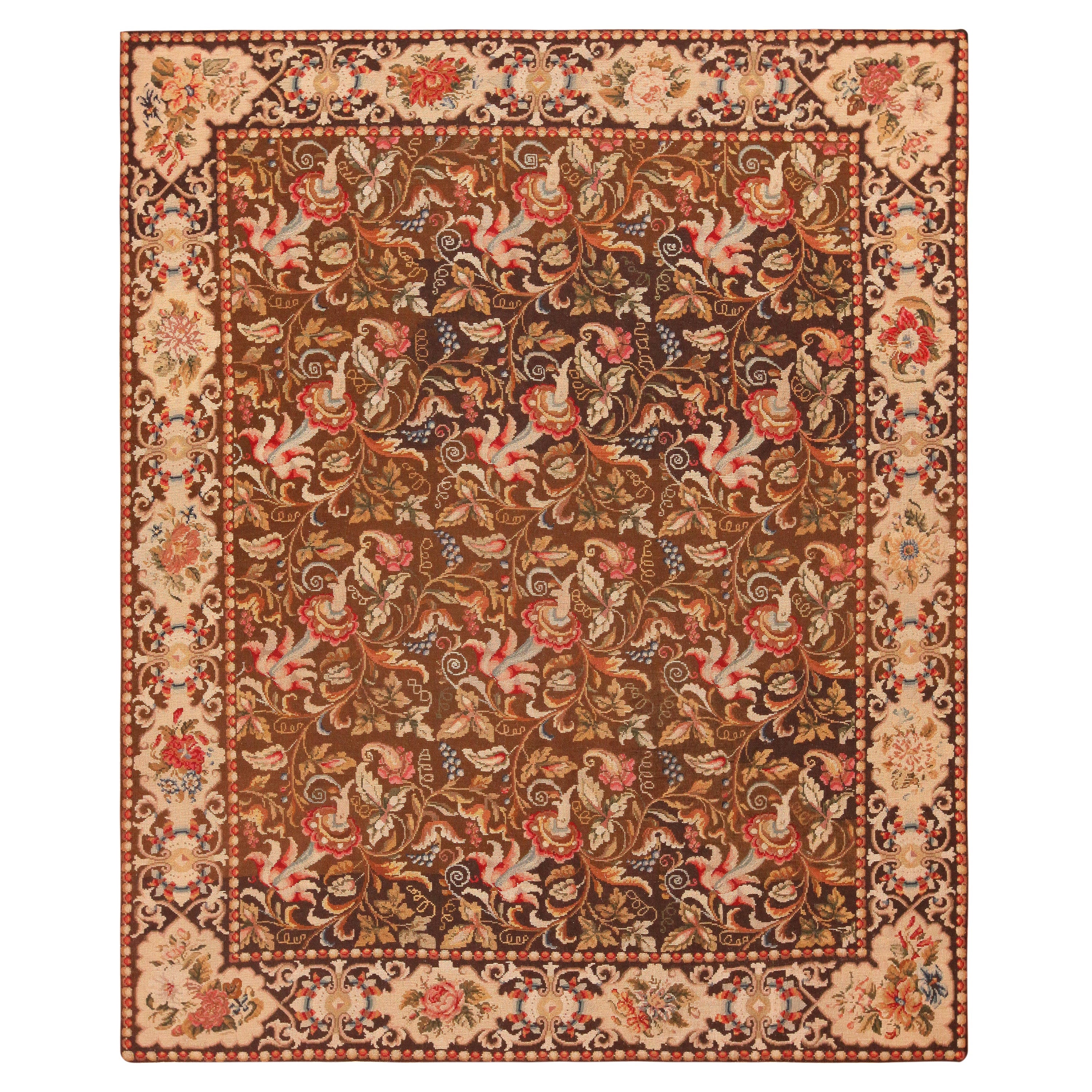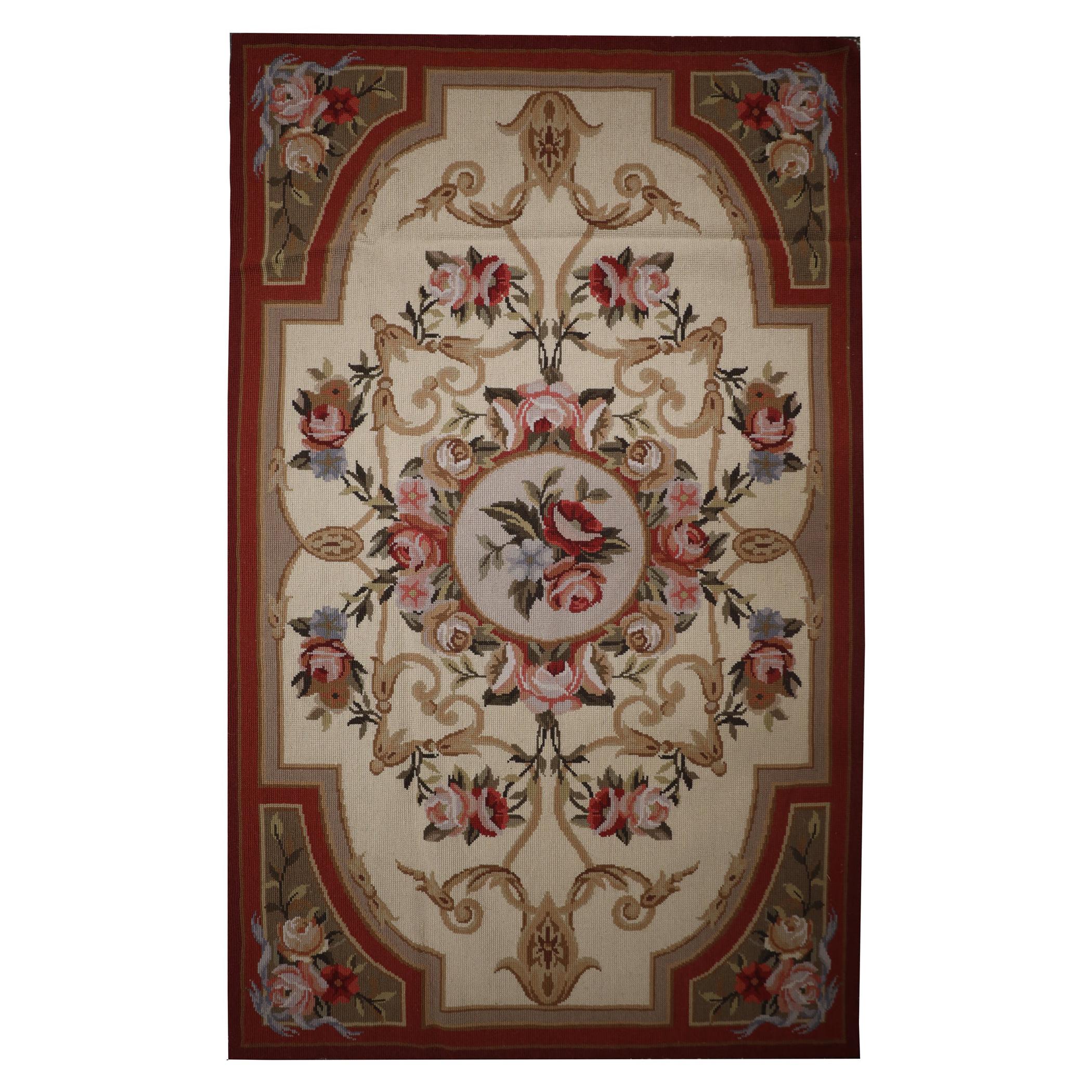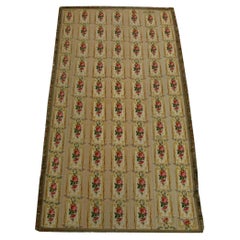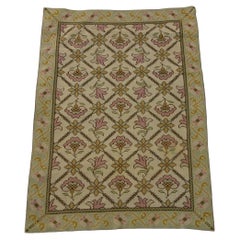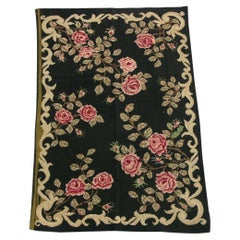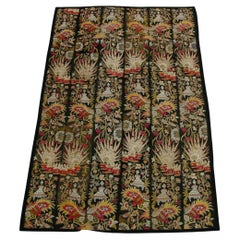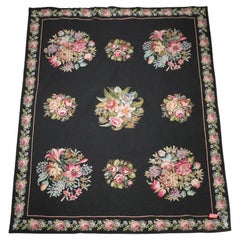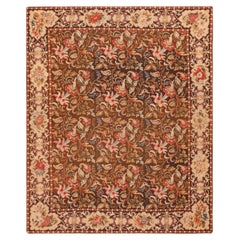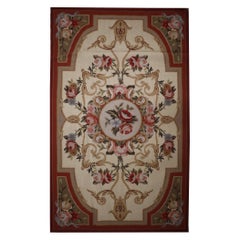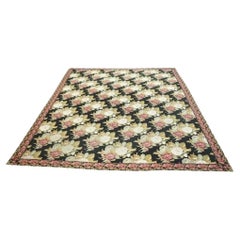Items Similar to 1950s Vintage Floral Design Needlepoint Rug
Want more images or videos?
Request additional images or videos from the seller
1 of 5
1950s Vintage Floral Design Needlepoint Rug
$3,375
£2,580.37
€2,972.06
CA$4,729.41
A$5,279.94
CHF 2,766.61
MX$64,631.66
NOK 35,135.97
SEK 33,128.76
DKK 22,180.80
Shipping
Retrieving quote...The 1stDibs Promise:
Authenticity Guarantee,
Money-Back Guarantee,
24-Hour Cancellation
About the Item
Ancient Roots Of Needlepoint Rugs
Archaeologists and scholars consider the roots of needlepoint to have been around 1500 BC. They consider the first needlepoint to include the fine diagonal stitches that were used to sew tents together by the ancient Egyptians. The art eventually evolved into tapestry weaving. However, a tapestry weaving differs significantly from needlepoint in that it uses a loom and vertical warp.
Tapestry weaving is closer to the weaving of kilims and pile rugs than canvas work. However, some still include tapestry weaving in the category of needlepoint because of the fine work that appeared during the late Renaissance. It can have a similar appearance to the untrained eye. Technically, tapestry weaving and needlepoint are not the same, and they do not use the same technique.
The first actual needlepoint rugs and needle-points began to appear in the late Renaissance. Needlepoint is worked by creating stitches on a stiff canvas. The canvas is typically made from jute or linen and is quite durable. Pieces from the Renaissance were used to cover footstools, chairs, pillows, bed headboards, and other furnishings. They were also used as table coverings and wall coverings. You could also find them on many small items such as purses, shoes, and various adornments for clothing.
During the Renaissance, the craft reached a high level of skill, and the designs became incredibly detailed and realistic. They mimicked many of the subjects and styles of famous paintings of the time. They created florals, still life designs, scenes, and geometric tiled pieces. Some of them mimicked the designs found in Persian Carpets.
Needlepoint reached its peak popularity in the 19th century when it was considered a proper occupation for a lady. Needlepoint and embroidery held a similar place in societal status at the time. During this time, the work became finer, with some of the canvas reaching a high level of detail. The level of detail is determined by counting the number of mesh in an inch. During this time petit point by French needlewomen could have a mesh count as high as 45 mesh. This allowed women to create highly intricate designs with incredible levels of detail.
Historical Needlepoint Carpets and Rugs
It is possible to find many antique pieces of needlepoint besides rugs. Needlepoint rugs were popular in France and Spain, where the technique was adapted to create highly intricate designs that mimicked the designs in architecture and fashion. They were popular because they were durable, and it could be fashioned into a variety of items. The canvases themselves were durable, and the wool that they used was also strong, which means that many of the pieces were able to withstand daily use. We have many artifacts that have survived from this time period.
Needlepoint rugs are important collectibles because they are different from the pile rugs and kilims that are typically found on the market. Needlepoint carpets are special because they take many hours to create, especially larger works. Needlepoint pieces of any type became popular throughout Europe during the 19th century. It is still a popular hobby today, but perhaps one of the most interesting stories is that of the Portuguese needlewomen of Arraiolos.
The story of these women and their beautiful carpets begins in 1492. Needlepoint was a popular occupation in Spain, which had a large population of Moors and Jews. They were an integral part of Spanish culture. However, in 1492, Queen Isabella of Spain issued a proclamation that gave these ethnic groups the order to pack their bags and board ships headed for shores unknown.
They had little time to grab their personal items and were only allowed to take items that were necessary for them to make a living and survive. All else had to be left behind. On one of these ships, a group of Jewish immigrants arrived in the southern Portuguese village of Arraiolos. They had very little with them to begin their new life, but the women had skills of needlework and began creating beautiful carpets that they could sell to support their families.
It became an important part of the community culture, and in the village groups of women could often be seen sitting together and working on these rugs. The designs are similar to those found on Spanish tilework. They brought these designs with them in their memory, and many of the rugs created by them resemble the colorful azulejo tiles. The beautiful design colors created by these women found their way into the European marketplace and became treasured heirloom pieces.
The Jewish women with their knowledge were able to take their displacement and tragedy to create beautiful works of art that would become famous around the world. Needlepoint rugs are a special place among carpet collectors and one that everyone should explore for the magnificent pieces that are available.
About the Seller
5.0
Platinum Seller
Premium sellers with a 4.7+ rating and 24-hour response times
Established in 1920
1stDibs seller since 2023
63 sales on 1stDibs
Typical response time: <1 hour
- ShippingRetrieving quote...Shipping from: Los Angeles, US
- Return Policy
Authenticity Guarantee
In the unlikely event there’s an issue with an item’s authenticity, contact us within 1 year for a full refund. DetailsMoney-Back Guarantee
If your item is not as described, is damaged in transit, or does not arrive, contact us within 7 days for a full refund. Details24-Hour Cancellation
You have a 24-hour grace period in which to reconsider your purchase, with no questions asked.Vetted Professional Sellers
Our world-class sellers must adhere to strict standards for service and quality, maintaining the integrity of our listings.Price-Match Guarantee
If you find that a seller listed the same item for a lower price elsewhere, we’ll match it.Trusted Global Delivery
Our best-in-class carrier network provides specialized shipping options worldwide, including custom delivery.More From This Seller
View All1920 Antique Floral Needlework Rug
Located in Los Angeles, US
Needlepoint rugs were created using the traditional needlework weaving technique that is used to make everyday items from furniture to carpets and artwork. However, it has a fascinat...
Category
Vintage 1920s Other Russian and Scandinavian Rugs
Materials
Wool, Cotton
Antique Needlepoint Floral Rug
Located in Los Angeles, US
Needlepoint rugs were created using the traditional needlework weaving technique that is used to make everyday items from furniture to carpets and artwork. However, it has a fascinat...
Category
Antique Early 1900s Other Russian and Scandinavian Rugs
Materials
Wool, Cotton
Antique Needlework Floral Rug
Located in Los Angeles, US
Needlepoint rugs were created using the traditional needlework weaving technique that is used to make everyday items from furniture to carpets and artwork. However, it has a fascinat...
Category
Antique Early 1900s Asian Other Russian and Scandinavian Rugs
Materials
Wool, Cotton
1920s Antique Floral Design Part Silk Needlework Rug
Located in Los Angeles, US
Needlepoint rugs were created using the traditional needlework weaving technique that is used to make everyday items from furniture to carpets and artwork. However, it has a fascinating history both as a hobby and as an industry. When many people think of carpets, they think of pile carpets or flat weave kilims, but needlepoint has also been used to create beautiful carpets. These carpets are durable and an important part of carpet history.
Archaeologists and scholars consider the roots of needlepoint to have been around 1500 BC. They consider the first needlepoint to include the fine diagonal stitches that were used to sew tents together by the ancient Egyptians. The art eventually evolved into tapestry weaving. However, a tapestry weaving differs significantly from needlepoint in that it uses a loom and vertical warp.
Tapestry weaving is closer to the weaving of kilims and pile rugs than canvas work. However, some still include tapestry weaving in the category of needlepoint because of the fine work that appeared during the late Renaissance. It can have a similar appearance to the untrained eye. Technically, tapestry weaving and needlepoint are not the same, and they do not use the same technique.
The first actual needlepoint rugs and needle-points began to appear in the late Renaissance. Needlepoint is worked by creating stitches on a stiff canvas. The canvas is typically made from jute or linen and is quite durable. Pieces from the Renaissance were used to cover footstools, chairs, pillows, bed headboards, and other furnishings. They were also used as table coverings and wall coverings. You could also find them on many small items such as purses, shoes, and various adornments for clothing.
During the Renaissance, the craft reached a high level of skill, and the designs became incredibly detailed and realistic. They mimicked many of the subjects and styles of famous paintings of the time. They created florals, still life designs, scenes, and geometric tiled pieces. Some of them mimicked the designs found in Persian Carpets.
Needlepoint reached its peak popularity in the 19th century when it was considered a proper occupation for a lady. Needlepoint and embroidery held a similar place in societal status at the time. During this time, the work became finer, with some of the canvas reaching a high level of detail. The level of detail is determined by counting the number of mesh in an inch. During this time petit point by French needlewomen could have a mesh count as high as 45 mesh. This allowed women to create highly intricate designs with incredible levels of detail.
It is possible to find many antique pieces of needlepoint besides rugs. Needlepoint rugs were popular in France and Spain, where the technique was adapted to create highly intricate designs that mimicked the designs in architecture and fashion. They were popular because they were durable, and it could be fashioned into a variety of items. The canvases themselves were durable, and the wool that they used was also strong, which means that many of the pieces were able to withstand daily use. We have many artifacts that have survived from this time period.
Needlepoint rugs are important collectibles because they are different from the pile rugs and kilims that are typically found on the market. Needlepoint carpets are special because they take many hours to create, especially larger works. Needlepoint pieces of any type became popular throughout Europe during the 19th century. It is still a popular hobby today, but perhaps one of the most interesting stories is that of the Portuguese needlewomen of Arraiolos.
The story of these women and their beautiful carpets begins in 1492. Needlepoint was a popular occupation in Spain, which had a large population of Moors and Jews. They were an integral part of Spanish culture. However, in 1492, Queen Isabella of Spain issued a proclamation that gave these ethnic groups the order to pack their bags and board ships headed...
Category
Vintage 1920s Renaissance Revival Russian and Scandinavian Rugs
Materials
Wool, Silk
Antique 1920 Floral Samarkand Rug
Located in Los Angeles, US
Antique Samarkand Rugs: The desert oasis of Khotan was an important stop on the Silk Road. The people of Khotan were expert carpet weavers who produced high quality antique rugs and ...
Category
Vintage 1920s Other Russian and Scandinavian Rugs
Materials
Wool, Cotton
1920s Antique Needlepoint Runner
Located in Los Angeles, US
The technique for creating needlepoint rugs and other objects made from needlepoint has remained unchanged since its beginnings in the 17th century. It all begins with a canvas with ...
Category
Vintage 1920s Other Russian and Scandinavian Rugs
Materials
Wool
You May Also Like
Vintage Floral Needlepoint Rug Tapestry - 9’ W x 12’ L
Located in Pittsburgh, PA
This large-scale vintage needlepoint rug / tapestry features a striking black ground, punctuated by alternating large and small bouquets of multicolored flowers. The floral motifs ar...
Category
Late 20th Century American North and South American Rugs
Materials
Wool
Floral Design Antique English Needlepoint Flat Weave Area Rug 6'3" x 7'9"
Located in New York, NY
Quite The Beautiful Floral Design Antique English Needlepoint Flat Weave Area Rug, Woven In: England, Circa / Date: Mid To Late 19th century
Category
Antique 19th Century English Other Western European Rugs
Materials
Wool
Traditional Wool Needlepoint Tapestry Rug, Floral Carpet Area Rug
Located in Wembley, GB
On the lookout for a new carpet to enhance your living room or bedroom? This Beautiful needlepoint could make the perfect accessory. This wool needlepoint is a traditional textile woven by hand. The central design has been woven on a simple cream background and features an elegant symmetrical floral...
Category
2010s Chinese Mid-Century Modern Central Asian Rugs
Materials
Wool, Cotton, Natural Fiber, Organic Material
Antique Large 164"x120" American Art Nouveau Floral Hand Hooked Wool Rug Carpet
Located in Philadelphia, PA
Antique Large 164"x120" American Art Nouveau Floral Hand Hooked Wool Rug Carpet. Item features a large impressive size, wonderful colors, very nice antique item, quality American cra...
Category
Early 20th Century Unknown Other North and South American Rugs
Materials
Wool
669 - 19th Century Needlepoint Rug Floral
Located in Paris, FR
669 - 19th century needlepoint rug floral.
Category
Antique 1880s French Aubusson Western European Rugs
Materials
Wool
Vintage Chinese Floral Needlepoint Rug with French Country Style
Located in Dallas, TX
77206 vintage Chinese floral needlepoint rug with French Country style. Various flower species grace the windows of an all-over compartment sty...
Category
Late 20th Century Chinese Country Chinese and East Asian Rugs
Materials
Wool
$1,596 Sale Price
20% Off
More Ways To Browse
Russian Architecture
Russia Chairs
1950s French Tapestry
1950s Embroidery
Antique Scandinavian Tables
Vintage 1950S Shoes
1950s Scandinavian Painting
Ethnic Vintage Clothing
Scandinavian Tile Table
19th Century European Still Life Paintings
Egyptian Clothing
Vintage Womens Shoes
Very Large French Tapestries
Meshed Rug
Chair Covers Tapestry
French Needlepoint Chairs
Egyptian Style Chair
Antique Portuguese Chairs
